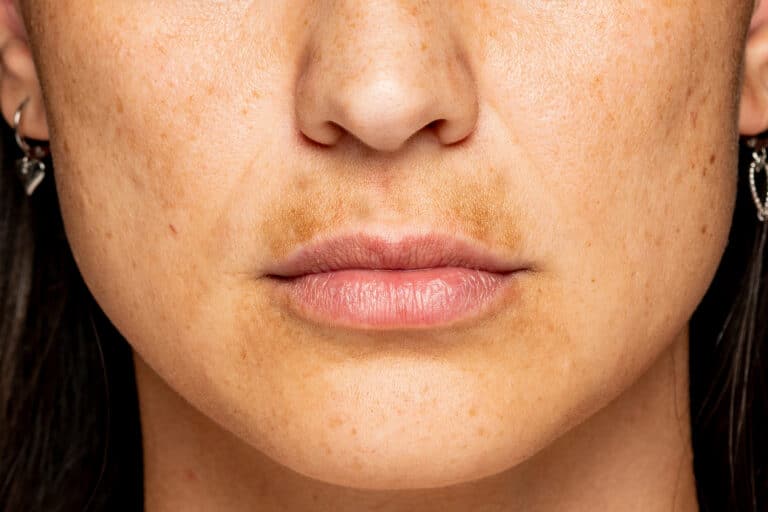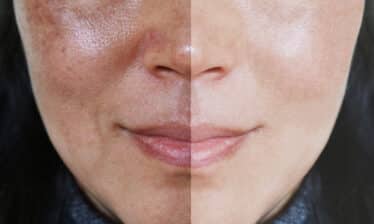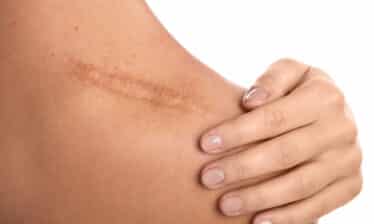A dark upper lip is a common skin concern called melasma, sometimes known as a melasma mustache or sun mustache.1 Melasma is a chronic skin condition that causes brown or gray patches across the skin and often affects people with darker complexion.2
There are many reasons for developing melasma. Some people are more prone to melasma because of genetics. Others get it because of underlying health conditions, hormonal shifts, medications, or sun exposure.3
Several treatments can help protect and brighten your skin, improving the appearance of a dark upper lip. For best results, address the causes and focus on prevention.4
- Address the Causes
Melasma happens for many different reasons. Learning how to get rid of a dark upper lip means understanding what causes it and addressing those factors.
- Wear Physical Sunscreen
UV rays from the sun stimulate your skin cells called melanocytes to produce more pigment known as melanin, which is your body’s way of protecting your skin against damage.5 Wear a physical mineral sunscreen with a 50+ SPF factor daily to prevent melasma and protect your skin after treatment.6
- Change Hormonal Medications
Hormones also play a role in the development of melasma. Increased hormones during pregnancy or from hormonal birth control stimulate melanocyte cells and cause extra melanin to appear in the skin.7 Melasma often disappears after you stop taking hormonal medications or when your pregnancy ends.8
- Treat Underlying Conditions
Thyroid disease is four times higher in people with melasma, suggesting a strong association between thyroid disease and skin discoloration.9 Treating thyroid disease may help improve your skin.
Treat Your Skin and Melasma Mustache
Certain topical products and prescription creams can brighten your skin and even out skin tone. Other treatments may be more appropriate for skin that doesn’t respond to products.
- Over-the-Counter Topical Treatments
Your skincare routine impacts the appearance of your skin and may help lighten your dark upper lip. For example, vitamin C and retinol block an enzyme called tyrosinase that converts an amino acid called tyrosine into melanin, evening out your skin tone.10
- Prescription Creams
Your dermatologist can also prescribe individual creams or combination treatments to reduce melasma. Hydroquinone, for example, blocks melanin conversion, while prescription retinol, called tretinoin, interrupts melanin production and turns over skin cells.11 These are often used with a corticosteroid to help lower inflammation.12
- Chemical Peels
If OTC and prescription creams don’t work, glycolic or salicylic acid peels may help treat a stubborn dark upper lip.13 Peels help turn over the pigmented skin cells, revealing brighter, even skin.14 These are best done under close supervision to prevent worsening skin discoloration.15
- Laser and Light Treatments
Laser and light treatments, such as intense pulsed light (IPL) and non-ablative fractional lasers, are another effective treatment for stubborn melasma. However, there is a high risk of the melasma returning after treatment.16 It may also worsen skin discoloration and may not be suitable for all skin types.17
Learn More About Skin Care
Melasma isn’t harmful, but it often resists treatment or comes back after being in the sun. Sunscreen and medications are often the most helpful. Explore My Skin Treatment articles for more information about healthy and effective skin care treatments.
SOURCES:
- Cleveland Clinic: “What Is a Melasma Mustache and How To Avoid Getting One.”
- International Journal of Environmental Research and Public Health: “Understanding Melasma-How Can Pharmacology and Cosmetology Procedures and Prevention Help to Achieve Optimal Treatment Results? A Narrative Review.”
- StatPearls: “Melasma.”
- International Journal of Environmental Research and Public Health: “Understanding Melasma-How Can Pharmacology and Cosmetology Procedures and Prevention Help to Achieve Optimal Treatment Results? A Narrative Review.”
- Photochemistry and Photobiology: “The Protective Role of Melanin Against UV Damage in Human Skin.”
- International Journal of Environmental Research and Public Health: “Understanding Melasma-How Can Pharmacology and Cosmetology Procedures and Prevention Help to Achieve Optimal Treatment Results? A Narrative Review.”
- StatPearls: “Melasma.”
- American Academy of Dermatology Association: “Melasma: Diagnosis and Treatment.”
- StatPearls: “Melasma.”
- International Journal of Environmental Research and Public Health: “Understanding Melasma-How Can Pharmacology and Cosmetology Procedures and Prevention Help to Achieve Optimal Treatment Results? A Narrative Review.”
- International Journal of Environmental Research and Public Health: “Understanding Melasma-How Can Pharmacology and Cosmetology Procedures and Prevention Help to Achieve Optimal Treatment Results? A Narrative Review.”
- American Academy of Dermatology Association: “Melasma: Diagnosis and Treatment.”
- StatPearls: “Melasma.”
- StatPearls: “Melasma.”
- StatPearls: “Melasma.”
- International Journal of Environmental Research and Public Health: “Understanding Melasma-How Can Pharmacology and Cosmetology Procedures and Prevention Help to Achieve Optimal Treatment Results? A Narrative Review.”
- International Journal of Environmental Research and Public Health: “Understanding Melasma-How Can Pharmacology and Cosmetology Procedures and Prevention Help to Achieve Optimal Treatment Results? A Narrative Review.”






